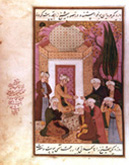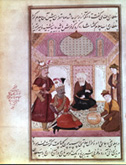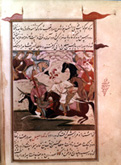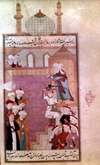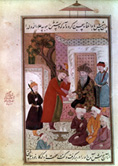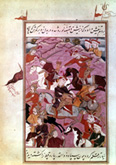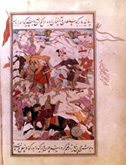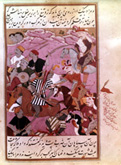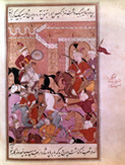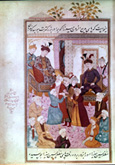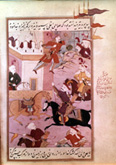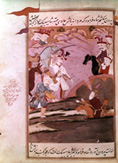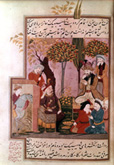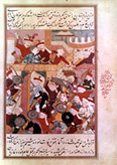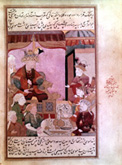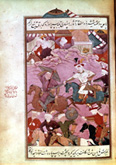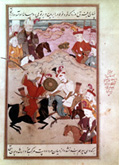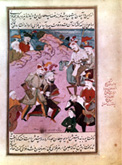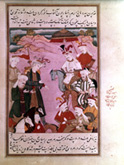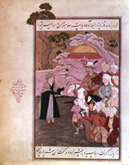Shaikh Zāhed Gilāni Appointing Shaikh Ṣafi to be His Successor as Head Mystic
Sultan Ḵˇāja ʿAli Siāh Puš Returning Timur's Whip
Timur Visits Sultan Ḵˇāja ʿAli Siāh Puš at Ardabil
Esmāʿil Kills Sultan Ḥoseyn Bārāni
Esmāʿil Celebrates the Rite of the Twelve Imams
Alvand Mirzā Torkmān Visits ʿAlā al-Dowla Ẕuʾl-Qadar
Battle Scene: Safavids and Ẕuʾl-Qadars in which Sāru Qapl¯n is Killed
Esmāʿil (?) Kills Bāyrak Solṭān
Morād Beg Kills the Ethiopian Slave
Bābor Šāh Chasing Šāhibeg Ḵān
Šāhibeg's Envoy Spying on the Sons of Sultan Ḥoseyn Mirzā Bāyqarā
Ḥalvāči Oḡli Unseating Jān Vafā Mirzā
ʿAḵi Solṭān Killing Juli the Uzbeg in Combat
Ādi Rescues Šāhibeg Ḵān From Drowning
Mirzā Moḥammad at the Court of Āqā Rostam
Najm Ṣāni Hangs Šayḵam Mirzā at the Gate of Qarši
Jāni Beg Visits Qāsem Ḵān
Shah Esmāʿil Kills Abuʾl Ḵeyr Ḵān in Battle
The Battle of Čalderān at which Shah Esmāʿil Defeats Malqoč-oḡli
Ḡazāli ʿArab Brought as a Prisoner Before Shah Esmāʿil
Shah Esmāʿil Receiving Ǧazāli Oḡli
Moʿin Moṣavver - manuscript M
History of Shah Esmāʿil
tāriḵ-e ʿālām-ārā-ye šāh esmāʿil
A complete(?) manuscript of good quality containing 353 folios describing events during the reign of Shah Esmāʿil, with a preamble on his progenitors. The Negarestan Museum, in which this manuscript was housed before the revolution, asserted that the manuscript was complete, but Mehdi Mahboubian, the previous owner claimed that more than one painting was extracted prior to his ownership, and was in private hands in Paris. It has not been possible to verify, or deny, the validity of this claim. Two loose pages in a private collection (see Ms. O), may indeed be the paintings referred to, or could be from another copy of the manuscript altogether; stylistically, it is well in keeping with the particulars of this manuscript down to the marginal inscriptions, but its dimensions are not available, thus making the determination, subject to doubt. The text contains various anachronisms referring to mid 17thcentury events, indicating that was probably compiled, not at the end of Shah Esmāʿil's reign as implied, but rather in 1087/1676-67 (Morton, Pembroke_1990, p.188). The author has not been identified. The calligraphy of this manuscript is written in good nastāʿliq, without columns, 15 lines to the page. Page size: 35.5 x 21.5 cm. The manuscript presently contains 21 paintings, including one (f.332v) inscribed in Moʿin’s handwriting, but that part of the inscription that might have included his signature has been smudged, and is now illegible. A later attribution next to it claims the painting to be the work of Moʿin Moṣavver. The twenty other paintings, although unsigned, are equally in the style of Moʿin, and can be attributed to him, albeit perhaps with workshop assistance.
Location:
Presently in the Reza Abbasi Museum, Tehran, having apparently been transferred there after the revolution from the Negarestan Museum where it was previously housed as collection no. 77.1.7. Prior to that it was in the Mahboubian Collection in New York.
Dating:
A reference in the text to 1087/1676-77 can be taken as the date of the manuscript's creation. The inscription on folio 332v contains a date, the middle of RabiʿI in the year 1010/September 1601. Since the date is stylistically impossible, the year intended might rather be interpreted as 1100/January 1689. The reversal of digits in dates involving zeros occurs often in the latter seventeenth century.
Bibliography:
Mahboubian_1972, no. 923. Morton, Pembroke_1990, p.188.
Robert Eng
Last Updated: November 30, 2010
Originally published: March 28, 2002
